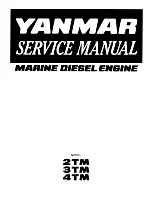
General arrangement and planning
29
Plan the engine room so as not to hinder engine
servicing work. Compare with the instruction book
and make sure that all filter replacesments, oil chang-
es and other servicing measures can be carried out
normally. Also ensure that it is possible to install and
remove the engine.
Before starting any installation work, make sure
that up-to-date dimensional drawings for the
engine and its equipment are used. Dimensional
drawings provide all the necessary measurements
for installation, such as the distance from the centre
of the crankshaft to the engine brackets (reverse gear
brackets) and to the centre line of the propeller shaft.
Note that the small silhouette drawings on leaflets
and brochures should
not be used for this purpose.
The engine and drive line should be installed in such
a way as to minimise noise and vibrations, i.e. air
noise and body noise (vibrations).
Vibrations from the engine and propeller are trans-
mitted via the suspension and engine bed out in the
hull. Other channels are via the exhaust pipe, coolant
pipes, fuel pipes, cabling, and control cables.
Pressure shocks from the propeller are transmitted
through the water into the hull. Pulsating force on the
propeller goes into the hull via the support brackets,
bearings and seals.
If the propeller is at a large angle this pulsating
pressure and force can be considerable. Use of an
incorrect propeller can result in cavitation, which also
causes noise and vibrations.
Torsional vibrations from correctly selected compo-
nents in the drive package are often negligible.
NOTE! Always consider international and local re-
quirements.
1. Engine room layout
Only use updated and approved dimensional draw-
ings. Study the drawings carefully. Consider sound-
proofing material, the engine’s movements when run-
ning and accessibility for servicing and repairs.
For twin installations, the distance between the en-
gines should be sufficient to allow easy performance
of inspection and service work.
2. Weight distribution
Consider the weight distribution of the boat so that it
is evenly distributed even with different levels of fuel
and water in the tanks. Place heavy units so that the
boat is balanced around the centre of gravity accord-
ing to the designer’s recommendations.
NOTE! Pay special attention to obtain the best centre
of gravity possible. This has a major influence on per-
formance in planing boats.
3. Choice of engine suspension type
Choose the appropriate type of engine suspension
based on comfort requirements, type of use and en-
gine/reverse gear arrangement.
The two major systems are fixed or flexible. In the
fixed system, the engine/reverse gear is directly bolt-
ed to the engine bed. While in flexible systems, the
engine/reverse gear is installed on flexible mounts.
Volvo Penta offers flexible mounts for a large variety
of engine/reverse gear combinations.
Select a shaft system depending on the type of cou-
pling (rigid or flexible), shaft support, stuffing box etc.
4. Fuel system
Determine the type of fuel system. Choose to use
fuel hoses or fuel pipes. Consider classification rules.
Decide where to place extra water separating fuel fil-
ters and plan for the routing of fuel hoses and pipes,
fuel filler and venting hoses, shut off devices etc. Fuel
feed and return hoses or pipes should be placed low
in the engine room so as not to transmit extra heat to
the fuel.
Summary of Contents for D11 series
Page 1: ...Marine Propulsion Diesel Engines Installation 1 1 D E D5 D16 series ...
Page 2: ......
Page 208: ...206 References to Service Bulletins Group No Date Concerns ...
Page 209: ...207 Notes ...
Page 210: ...208 Notes ...
Page 212: ...7748655 English 11 2007 ...
















































